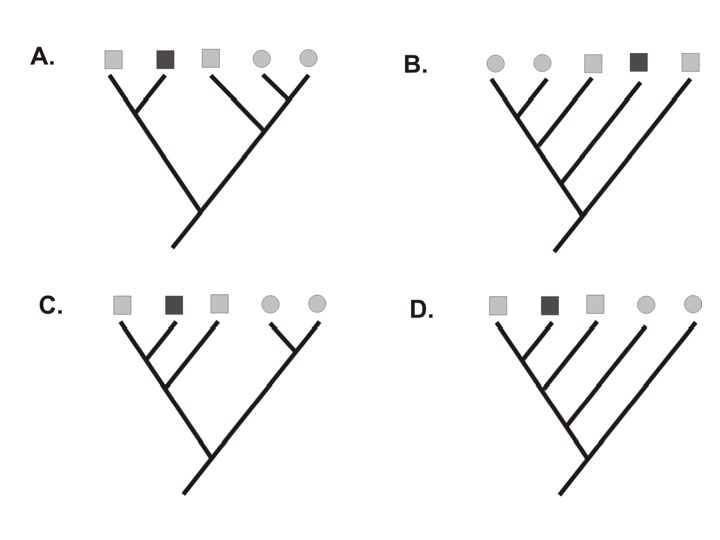It is possible to write multi-choice questions that address specific levels in the taxonomy of cognitive learning (see: Lord & Baviskar 2007, Journal of College Science Teaching 36: 40-46). The choice of verb used in a question can be critical in that respect. The Blooming Peacock shown below (source: http://ilearntechnology.com/?p=2973) illustrates the types of phrases typically associated with each level of Bloom's taxonomy.

Similarly, the folowing table lists question cues and verbs matched to each level in Anderson and Krathwohl's revised taxonomy (adapted from ANDERSON & KRATHWOHL 2001, A Taxonomy for Learning, Teaching, and Assessing: A Revision of Bloom's Taxonomy of Educational Objectives. New York: Longman).
Cognitive Process
|
Question cues/verbs
|
Remember
|
Recognise (identify), recall (retrieve) |
Understand
|
Interpret (clarify, paraphrase, represent, translate), exemplify (illustrate, instantiate), classify (categorise, subsume), summarize (abstract, generalize) infer (conclude, extrapolate, interpolate, predict), compare (contrast, map, match), explain (construct model) |
Apply
|
Execute (carry out), implement (use) |
Analyze
|
Differentiate (discriminate, distinguish, focus, select), organize (find coherence, integrate, outline, structure), attribute (deconstruct) |
Evaluate
|
Check (coordinate, detect, monitor, test), critique (judge) |
Create
|
Generate (hypothesise), plan (design), produce (construct) |
Higher order or lower order?
It is a matter for debate at which level in the taxonomy lower order turns into higher order. Some workers consider everything from understanding and above to be higher order, whilst others argue that applying is the benchmark. Here, we mostly use the term in reference to the three highest levels on Bloom's taxonomy: analysing, evaluating and creating.
Worked example (phylogenetics topic)
Remembering- ask students to remember relevant facts, concepts or procedures. Recall questions do not assess understanding, and rarely lead to discussion, but can be useful for reviewing pre-class readings or previous sessions, or for diagnosing the level of knowledge the students already have. Often students need to know certain facts about a topic before they can proceed with deeper understanding and higher cognitive thinking. Recall clicker questions can be used to ensure the base knowledge is there before proceeding.
Paraphyly can be defined as a:
A. group of organisms that form a clade, consisting of a last common ancestor and all of its descendants.
B. taxonomic group consisting of an ancestor and some of its descendants
C. taxonomic group that does not share a common ancestor
This question is considered remembergin level as it simply requires students to have learnt the definition of the term paraphyly
Click here to search for all questions tagged 'remembering'
Understanding - these questions require students to not only recall the definition of a particular term, but also to understand the concepts associated with it. If incorrect answers are based on common student misconceptions understanding questions can often lead to split votes, which can be useful for leading into class discussions
Which one of these is an example of a paraphyletic group?

(correct answer is C)
This question is considered understanding level as it requires interpretation of a visual representation of a concept.
Click here to search for all questions tagged 'understanding'
Applying - questions at this level require students to apply their knowledge and understanding to particular situations and contexts.
Which diagram represents the most parsimonious tree?

Correct answer is C (but what about 'B'? can lead an interesting discussion into their relative merits)
This question is considered application level as it requires students to know the definition of parsimony, understand how it would be represented visual and apply that knowledge to the question in hand.
Clicker here to search for all questions tagged 'applying'
Higher order questions – include questions at the top levels of Bloom’s taxonomy – analysis, evaluation and creation (although creation is pretty much impossible to assess with multiple choice questions!). Analysis emphasises the breakdown of the material into its constituent parts and detection of the relationships of the parts and of the way they are organised. Evaluation is concerned with judgements and evaluations of others judgements. Self-evaluation or meta-cognition is an important aspect of this.
Example analysis question
Two students are discussing the various benefits and weaknesses of different classification systems. Student X says that it is best to base taxonomic decisions on evolutionary relationships among organisms, as this is the only way to make objective classifications. Monophyletic groups based on shared derived character states are therefore the best basis for delimiting species. It is important to have species that are intuitive to the end user and that paraphyletic groups often achieve this.
Which statement from the paragraph above does not support student X’s central argument?
A. it is best to base taxonomic decisions on evolutionary relationships among organisms
B. this is the only way to make objective classifications
C. Monophyletic groups based on shared derived character states are therefore the best basis for delimiting species
D. It is most important to have species that are intuitive to the end user
This question is considered at an anlysis level as the students are required to break down the argument into different parts and select which sentences support the argument.
Click here to search for all questions tagged 'higher order'
Click here to search for all questions tagged 'analysis'
Click here to search for all questions tagged 'evaluation'
Comments (0)
You don't have permission to comment on this page.